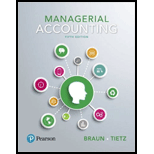
Managerial Accounting, Student Value Edition Plus MyLab Accounting with Pearson eText -- Access Card Package (5th Edition)
5th Edition
ISBN: 9780134642093
Author: Karen W. Braun, Wendy M. Tietz
Publisher: PEARSON
expand_more
expand_more
format_list_bulleted
Concept explainers
Question
Chapter 9, Problem 9.54BE
1.
To determine
To explain: The total sales revenue is expected to be paid in cash.
2.
To determine
The number of customer transactions does the company expect in January.
3.
To determine
The total sales revenue is expected to be paid with credit cards.
4.
To determine
The number of customer transactions that will be paid for by customers using credit cards.
5.
To determine
The restaurant expectation to incur in credit card transaction fees.
6.
To determine
The total sales revenue is expected to be paid with debit cards.
7.
To determine
The number of customer transactions that will be paid for by customers using debit cards.
8.
To determine
To explain: The restaurant expectation to incur in debit card transaction fees.
9.
To determine
The deposited in the restaurant’s bank account during the month of January related to credit and debit card sales.
10.
To determine
The total amount of money that the restaurant expects to deposit in its bank account during the month of January from cash, credit card, and debit card sales.
Expert Solution & Answer
Want to see the full answer?
Check out a sample textbook solution
Students have asked these similar questions
I need help with this general accounting question using standard accounting techniques.
None
Please provide the accurate answer to this general accounting problem using valid techniques.
Chapter 9 Solutions
Managerial Accounting, Student Value Edition Plus MyLab Accounting with Pearson eText -- Access Card Package (5th Edition)
Ch. 9 - (Learning Objective 1) Which term describes the...Ch. 9 - (Learning Objective 1) Benefits of budgeting...Ch. 9 - Prob. 3QCCh. 9 - Prob. 4QCCh. 9 - Prob. 5QCCh. 9 - Prob. 6QCCh. 9 - Prob. 7QCCh. 9 - Prob. 8QCCh. 9 - Prob. 9QCCh. 9 - Prob. 10QC
Ch. 9 - Short Exercises S9-1 Order of preparation and...Ch. 9 - Explain why companies use zero-based budgeting...Ch. 9 - Understanding key terms and definitions (Learning...Ch. 9 - Sales Budget (Learning Objective 2) Jefferson...Ch. 9 - Production budget (Learning Objective 2) Nichols...Ch. 9 - Direct materials budget (Learning Objective 2)...Ch. 9 - Prob. 9.7SECh. 9 - Prob. 9.8SECh. 9 - Prob. 9.9SECh. 9 - Prob. 9.10SECh. 9 - Prob. 9.11SECh. 9 - Cash payments budget (Learning Objective 3) Finley...Ch. 9 - Cash budget (Learning Objective 3) SaveCo...Ch. 9 - Prob. 9.14SECh. 9 - Prob. 9.15SECh. 9 - Identify ethical standards violated (Learning...Ch. 9 - Prob. 9.17AECh. 9 - Sales budget for a retail organization (Learning...Ch. 9 - Prob. 9.19AECh. 9 - Production budget (Learning Objective 2) Hoffman...Ch. 9 - Direct materials budget (Learning Objective 2)...Ch. 9 - Production and direct materials budgets (Learning...Ch. 9 - Direct labor budget (Learning Objective 2)...Ch. 9 - Manufacturing overhead budget (Learning Objective...Ch. 9 - Operating expenses budget and an income statement...Ch. 9 - Budgeted income statement (Learning Objective 2)...Ch. 9 - Prob. 9.27AECh. 9 - Cash collections budget (Learning Objective 3)...Ch. 9 - Cash payments budget (Learning Objective 3) The...Ch. 9 - Prob. 9.30AECh. 9 - Prob. 9.31AECh. 9 - Budgeted balance sheet (Learning Objective 3) Use...Ch. 9 - Prob. 9.33AECh. 9 - Prob. 9.34AECh. 9 - Cost of goods sold, inventory, and purchases...Ch. 9 - Cost of goods sold, inventory, and purchases...Ch. 9 - Prob. 9.37BECh. 9 - Prob. 9.38BECh. 9 - Prob. 9.39BECh. 9 - Prob. 9.40BECh. 9 - Direct materials budget (Learning Objective 2) Moe...Ch. 9 - Prob. 9.42BECh. 9 - Prob. 9.43BECh. 9 - Manufacturing overhead budget (Learning Objective...Ch. 9 - Prob. 9.45BECh. 9 - Prob. 9.46BECh. 9 - Prob. 9.47BECh. 9 - Prob. 9.48BECh. 9 - Prob. 9.49BECh. 9 - Combined cash budget (Learning Objective 3)...Ch. 9 - Sales and cash collections budgets (Learning...Ch. 9 - Prob. 9.52BECh. 9 - Prob. 9.53BECh. 9 - Prob. 9.54BECh. 9 - Prob. 9.55BECh. 9 - Prob. 9.56BECh. 9 - Comprehensive budgeting problem (Learning...Ch. 9 - Cash budgets under two alternatives (Learning...Ch. 9 - Comprehensive summary problem (Learning Objectives...Ch. 9 - Prob. 9.60APCh. 9 - Cash budgets (Learning Objective 3) Elis...Ch. 9 - Prob. 9.62APCh. 9 - Cost of goods sold, inventory, and purchases...Ch. 9 - Prob. 9.64APCh. 9 - Problems Group B P9-65B Comprehensive budgeting...Ch. 9 - Cash budgets under two alternatives (Learning...Ch. 9 - Comprehensive summary problem (Learning Objectives...Ch. 9 - Prob. 9.68BPCh. 9 - Cash budgets (Learning Objective 3) Ivans...Ch. 9 - Combined cash budget and a budgeted balance sheet...Ch. 9 - Prob. 9.71BPCh. 9 - Prepare comprehensive budgets for a retailer...Ch. 9 - Prob. 9.73SCCh. 9 - Discussion Questions 1. The sales budget is the...Ch. 9 - Budgeting for a Single Product In this activity,...Ch. 9 - Ethics and budgetary slack (Learning Objectives 1,...Ch. 9 - Prob. 9.77ACT
Knowledge Booster
Learn more about
Need a deep-dive on the concept behind this application? Look no further. Learn more about this topic, accounting and related others by exploring similar questions and additional content below.Similar questions
- Please provide the accurate answer to this financial accounting problem using appropriate methods.arrow_forwardPlease provide the correct answer to this general accounting problem using accurate calculations.arrow_forwardCan you help me solve this general accounting problem using the correct accounting process?arrow_forward
arrow_back_ios
SEE MORE QUESTIONS
arrow_forward_ios
Recommended textbooks for you
 Intermediate Accounting: Reporting And AnalysisAccountingISBN:9781337788281Author:James M. Wahlen, Jefferson P. Jones, Donald PagachPublisher:Cengage LearningPrinciples of Accounting Volume 1AccountingISBN:9781947172685Author:OpenStaxPublisher:OpenStax College
Intermediate Accounting: Reporting And AnalysisAccountingISBN:9781337788281Author:James M. Wahlen, Jefferson P. Jones, Donald PagachPublisher:Cengage LearningPrinciples of Accounting Volume 1AccountingISBN:9781947172685Author:OpenStaxPublisher:OpenStax College

Intermediate Accounting: Reporting And Analysis
Accounting
ISBN:9781337788281
Author:James M. Wahlen, Jefferson P. Jones, Donald Pagach
Publisher:Cengage Learning

Principles of Accounting Volume 1
Accounting
ISBN:9781947172685
Author:OpenStax
Publisher:OpenStax College
The accounting cycle; Author: Alanis Business academy;https://www.youtube.com/watch?v=XTspj8CtzPk;License: Standard YouTube License, CC-BY